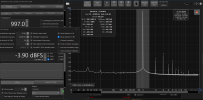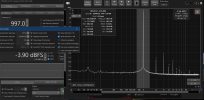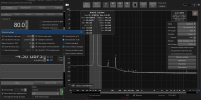-
Welcome to ASR. There are many reviews of audio hardware and expert members to help answer your questions. Click here to have your audio equipment measured for free!
You are using an out of date browser. It may not display this or other websites correctly.
You should upgrade or use an alternative browser.
You should upgrade or use an alternative browser.
Using Cross Corelation to lower influence of ADC for DAC measurements
- Thread starter Rja4000
- Start date
Sokel
Master Contributor
- Joined
- Sep 8, 2021
- Messages
- 9,606
- Likes
- 10,299
As for your question,in my case before fixing my thing,using the option resulted in zero disappeared bins,just a nice chart.It would be interesting to see the "cross-correlation magnitude" in comparison.
My expectation is that it ends up at fairly the same level as the "+3% crossfeed" but with almost no bins going zero.
KSTR
Major Contributor
Yes, it did work before, but now it doesn't, no matter what I do (also with real-time input, not from file).

Trying full re-install...
Trying full re-install...
KSTR
Major Contributor
^ Sadly, no success. REW 5.40 Beta 50 on Linux Mint 20.1
Sokel
Master Contributor
- Joined
- Sep 8, 2021
- Messages
- 9,606
- Likes
- 10,299
Tried your settings and it's working.^ Sadly, no success. REW 5.40 Beta 50 on Linux Mint 20.1
On windows though.
Select "Show distortion".Sadly, no success. REW 5.40 Beta 50 on Linux Mint 20.1
FrenchFan
Active Member
- Joined
- Mar 12, 2024
- Messages
- 177
- Likes
- 82
KSTR^ Sadly, no success. REW 5.40 Beta 50 on Linux Mint 20.1
I just tried 5 minutes ago
I have the same configuration as you:
For me it seems OK.
My noise level goes down well
according to the NB of correlation.
You will have to reinstall, I think.
There is something that cracked.
PRETTY_NAME="Linux Mint 21.1"
VERSION_ID="21.1"
REW 5.40 beta 50
FrenchFan
Active Member
- Joined
- Mar 12, 2024
- Messages
- 177
- Likes
- 82
not 32K average forever^ Sadly, no success. REW 5.40 Beta 50 on Linux Mint 20.1
KSTR
Major Contributor
Already did a full uninstall including purged settings, then reinstall.
No matter what I try, REW doesn't average with CCA Magnitude and it also doesn't show the average count like it does with any other settings (Std Mag, Coherent, CCA R0+).
Quite weird, indeed. Might try on a different Linux machine later....
EDIT: I see John gave the answer just above
No matter what I try, REW doesn't average with CCA Magnitude and it also doesn't show the average count like it does with any other settings (Std Mag, Coherent, CCA R0+).
Quite weird, indeed. Might try on a different Linux machine later....
EDIT: I see John gave the answer just above
KSTR
Major Contributor
Spot on, +0.2dB difference. And no zero bins at all (by design).It would be interesting to see the "cross-correlation magnitude" in comparison.
My expectation is that it ends up at fairly the same level as the "+3% crossfeed" but with almost no bins going zero.
nanook
Senior Member
The point is that phase differences between the two ADCs used for the cross-correlation do compromise the cc result.@KSTR got me so scared that I didn't want to measure an el. x-over with all the phase differences it may present
Turns out to be ok though:
When you feed both ADCs with the identical signal (y-cable), the signal from the x-over is a signal just like any other signal and this analysis works as expected.
nanook
Senior Member
I was expecting some bins to be close to zero yet positive and thus not suppressed, but for some reason they seem to not show up.Spot on, +0.2dB difference. And no zero bins at all (by design).
KSTR
Major Contributor
I found that largest span of bin max to bin min values can be on the order of 50dB, with a brutally large FFT size of 4M and a rectangular window. For single CC Mag FFT, no averaging, that is.I was expecting some bins to be close to zero yet positive and thus not suppressed, but for some reason they seem to not show up.
Magnitudes dropping below -230dBFS (REW's display limit) don't seem to ever happen in any normal use case with CCA Mag.
FrenchFan
Active Member
- Joined
- Mar 12, 2024
- Messages
- 177
- Likes
- 82
OK another plane
Can you tell me what is your ADC
E1DA cosmos iso A,B or C .
I see that there are still peaks around -240 dB , I think that you
are not yet at the THD+N floor and there is a difference
of 0.6 db between cross correlation and cross correlation magnitude .
So there must be a little missing .
If ADC = iso B that means that you have an ADC noise of
-122dBFS - 15 dB of correlation -> so -137dBFS you are
only at 4 dB of your DAC noise , try to go up to 3000 correlations.
Use FFT lenght = 32k it is enought .
And tell me what you get ?
I am interested
Thanks in advance
Last edited:
restorer-john
Grand Contributor
Would it be fair to say that Amirs AP555 is now being outperformed by these top end dacs?
The DAC based generator in the APX555 is easily outperformed by many DACs, but the high perfrormance analogue sine generator in Amir's particular unit is, from what I can see, a particularly good one. THD is off the chart low. Noise is the limitation now.
The analyzer generators can of course drive to much higher levels (~26V) and that means there is gain. With gain comes some noise at those high levels.
FrenchFan
Active Member
- Joined
- Mar 12, 2024
- Messages
- 177
- Likes
- 82
Hi jamesdysonWould it be fair to say that Amirs AP555 is now being outperformed by these top end dacs? It's limit being below 124dB.
Thanks for the feedback.
When the correlation converges CC and CCmagnitude
get closer I see that the diff ~0.3db.
Here we can say that the measurement is correct,
and that your DAC really has THD+N = -130dBFS
and a little more in dBFSA.
Concerning the APx 555 for the THD+N it's over for him,
but concerning the THD he is still in the race
with his system with 2 ADC + sliding filter,
in addition he does a lot of other things.
I think like @restorer-john
We need to tackle the distortion measurement like APx does
we have 2 ADCs on the E1DA cosmos, now we need ideas
+ an E1DA cosmos APU that filters at 1000 and 10000Hz to at least
make these measurements on 2 frequencies .
Anyway I think APx will have a bell ringing about
cross correlation and that the implementation is only a matter of
time .
It can do the same principle today as with
the E1DA cosmos APU to gain dB for the THD+N measurement,
it has notch filters .
nanook
Senior Member
The AP does all this with proper input protection and gain ranging.Agreed. The AP ADC does also seem to be a limitation. It looks like the E1DA can also outperform it even without cross correlation.
If it's about sine or sweeps, the tracking notch of the AP is a great feature.
If it comes to multitone, the E1DA ADC will likely beat it - for sure when using cross-correlation.
Similar threads
- Replies
- 0
- Views
- 455
- Replies
- 6
- Views
- 2K
- Replies
- 1
- Views
- 648
- Replies
- 10
- Views
- 2K
- Replies
- 88
- Views
- 23K



